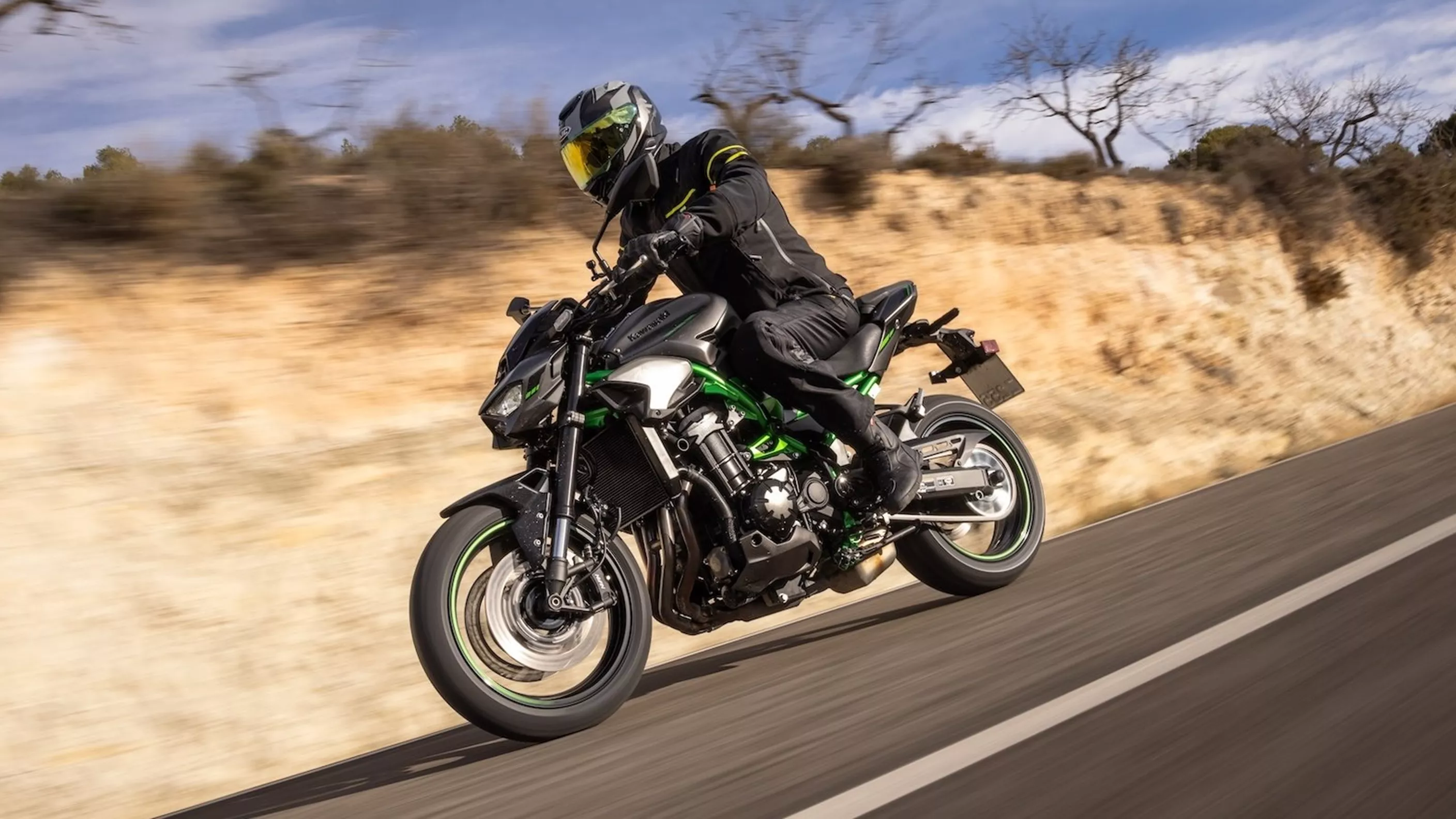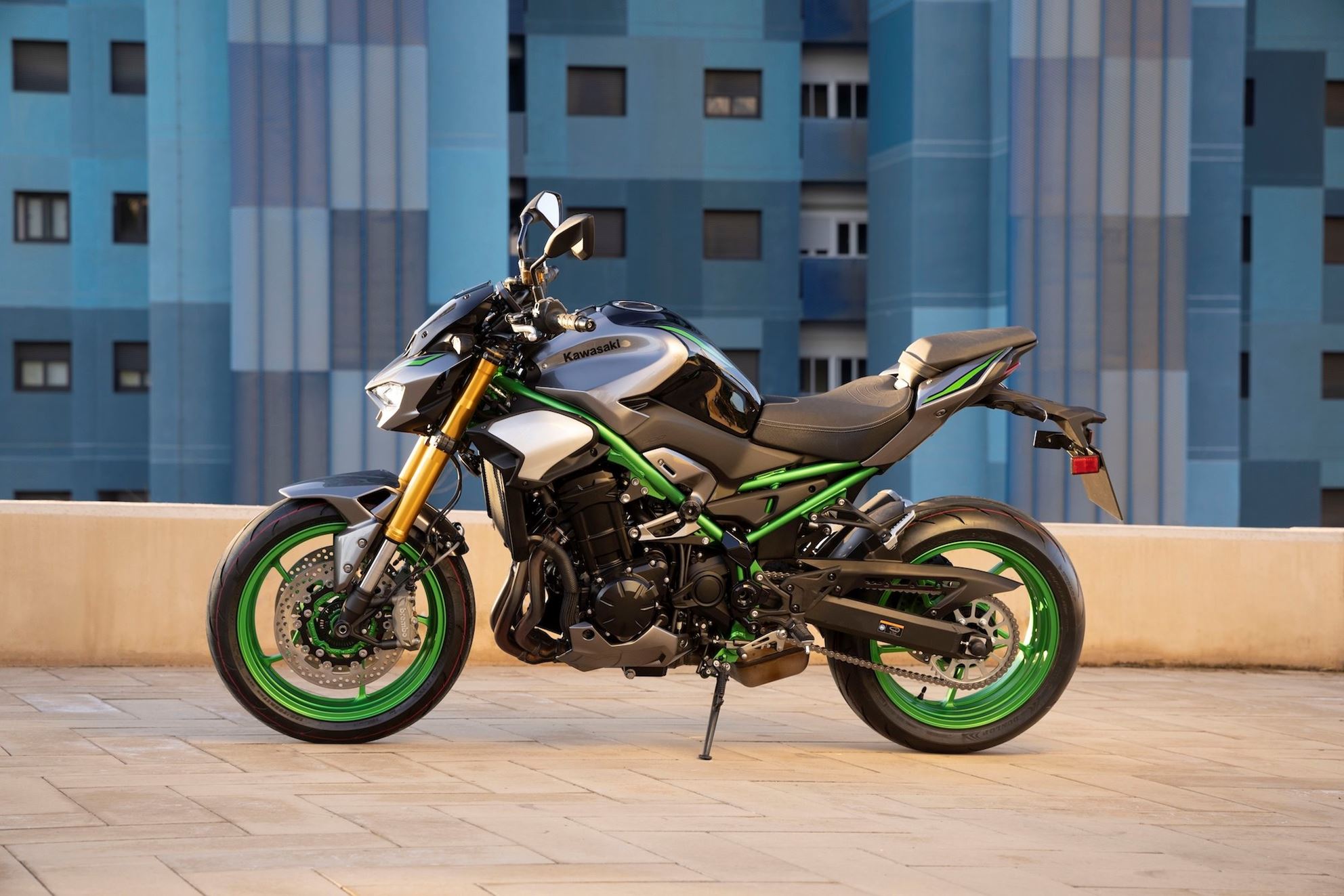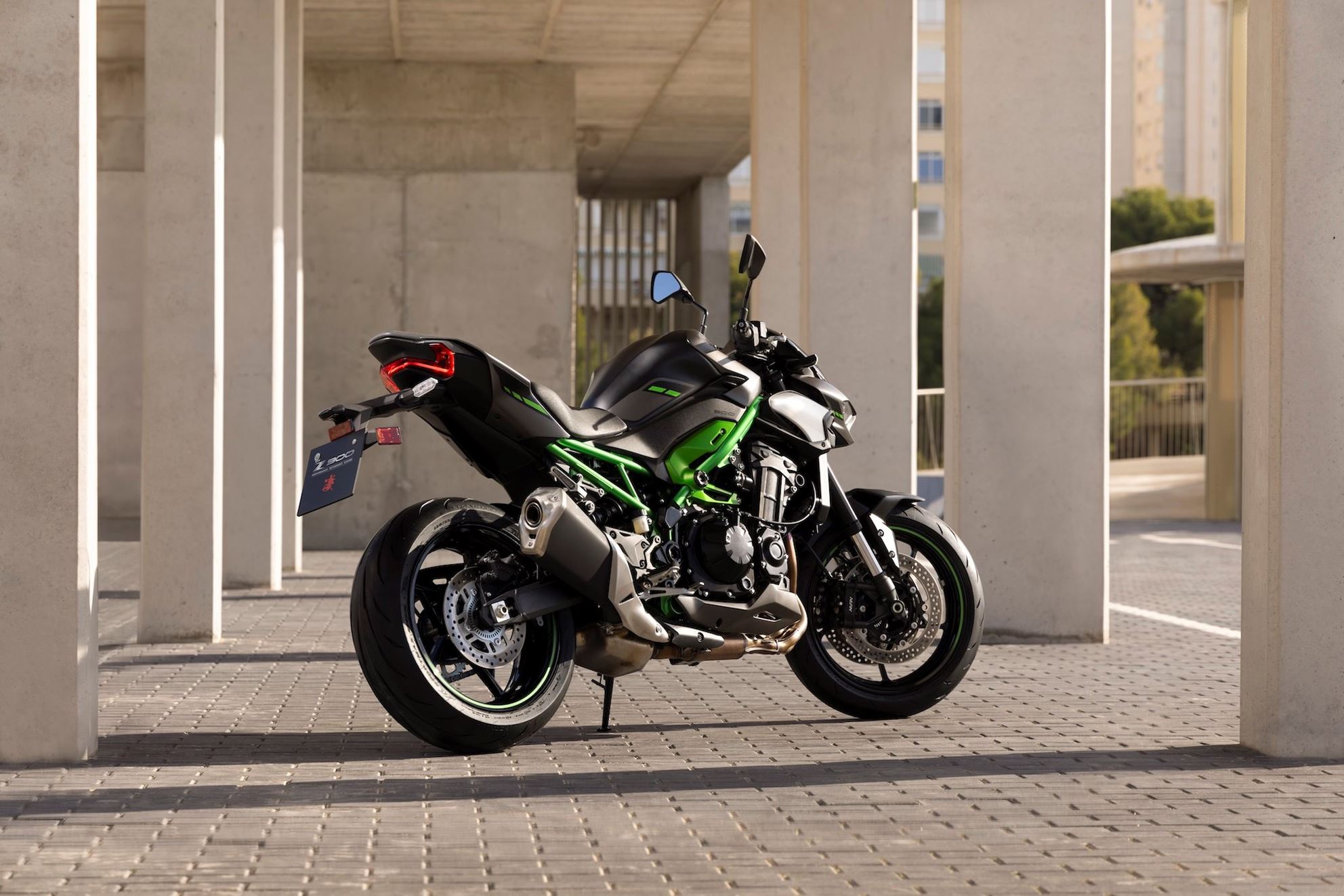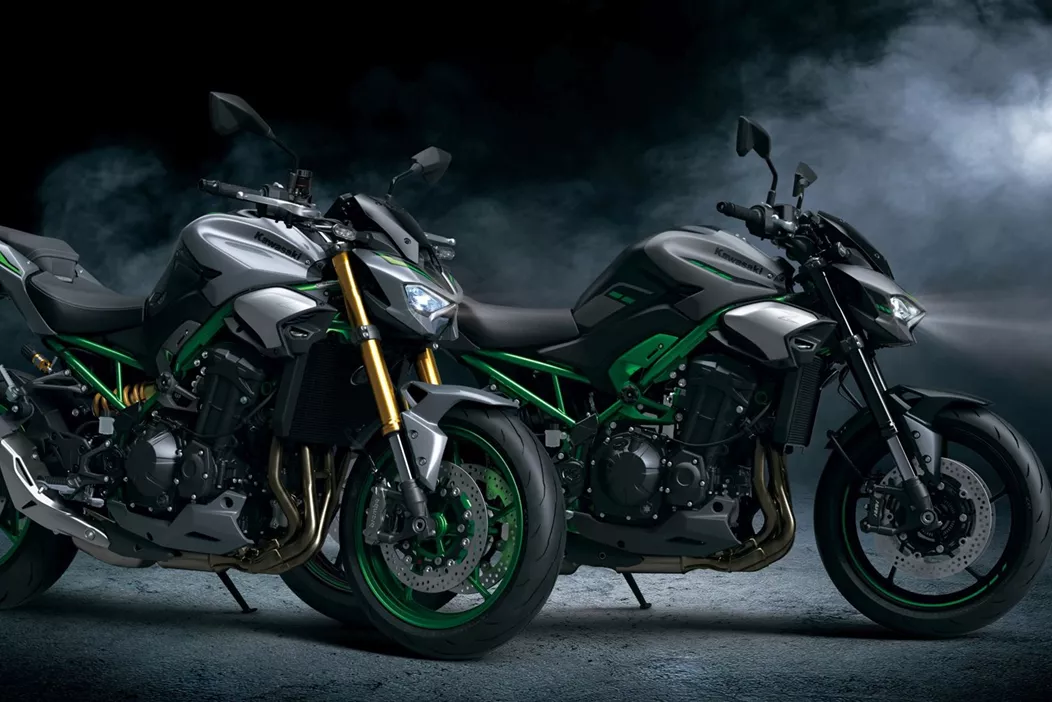No matter how long you've been in the game, this sight always warms my soul! Early morning, and here they stand—a whole fleet of brand-new motorcycles. Freshly polished, new tires, perfectly lined up. Naturally, the light is hitting just right, and the entire Z900 lineup shines brilliantly in the Spanish sun. At this moment, they already look incredibly desirable. They appear powerful, muscular, and the engineering is on full display! The Z900 embodies the naked bike ethos like no other motorcycle on the market. The mighty inline-four powerplant bursts from the frame, defining the bike with its massive powerplant, two wheels, a wide handlebar, and an unmistakable design. I can hardly wait to press the start button and bring the Japanese beast to life. But first, let's take a look at the starting position.

Kawasaki Z900 2025 Review
How Well Does the New Z900 Ride?
How well does the new Kawasaki Z900 perform in the 2025 model year? In our test in Spain, this Japanese 4-cylinder naked bike has to prove if the upgrade has hit the mark. The community's expectations are high.
&width=72&height=72&bgcolor=rgba_39_42_44_0&mode=crop)
nastynils
published on 22/01/2025
The Z900 2025 vs. Its Predecessor: A Technical Comparison
The new Z900 has been carefully refined by Kawasaki, as seen in the technical data comparison. The proven 948cc inline-four engine loses a slight amount of power: instead of 125 hp, it now delivers 124 hp at an unchanged 9,500 rpm. The maximum torque also drops slightly from 98.6 to 97.4 Nm. The biggest difference lies in the electronics: for the first time, the 2025 version features a 6-axis Inertial Measurement Unit (IMU), enabling cornering ABS, along with a standard up/down quickshifter and cruise control. In terms of the chassis, the significantly higher seat height is notable: it increases from 795 mm to 830 mm. The caster angle has also been extended from 105 mm to 110 mm. The weight increases only slightly by 1 kg to 213 kg ready to ride. The geometry of the steel frame chassis remains unchanged with a 1,450 mm wheelbase, as do the suspension components with a 41mm USD fork up front (120 mm travel) and a monoshock at the rear (140 mm). The braking system with 300 mm dual discs at the front and a 250 mm single disc at the rear has also been retained. Kawasaki promises a reduced fuel consumption of 4.8 l/100km, which is a quite attractive figure in this class.
What Does the 1000PS Community Say About the 2025 Model?
On our German-speaking YouTube channel, we've already uploaded a video about the Z900. My colleague Poky reported on the new model there, and our 1000PS community has been actively discussing the new Kawasaki Z900.
Opinions in our community are quite divided on the new Z900—and as you know, our 1000PS members and viewers don't hold back! While some welcome the update featuring a quickshifter, IMU, and more advanced electronics as long overdue, many are puzzled by the lack of a power increase. "213 kg with 124 hp? It's 2025!" I read in the comments. The new Honda Hornet 1000 seems like a tempting alternative to many. However, what's interesting is that loyal Z900 riders among you still praise the bike's reliability and everyday practicality. "Once you've ridden a Z900, you don't switch easily," writes one of our viewers. The new design divides opinions—especially the missing Z-shaped taillight is missed by many. The increased seat height of 830 mm (up from 795 mm) is also viewed critically by some. But what everyone really praises is the moderate price of under €10,000 (price for Germany) for the base model, which is quite a statement in today's market. My takeaway from your comments? The Z900 stays true to itself—with all its pros and cons. Whether that's enough for a top spot in registration numbers? The current season will tell!

The New Kawasaki Z900 2025
Community Questions - What Topics Matter to You?
Before a test ride, we love to consult with our 1000PS community. What should we focus on? Which topics are most important to you? Based on feedback from our loyal fans, I should pay attention to the following topics during the upcoming test ride:
The most frequently asked question from our community is clearly the comparison to the new Honda CB 1000 Hornet—it's really got you on the edge of your seats! You mainly want to know which bike performs better on country roads and how the power difference in the mid-range makes itself felt. Many of you are also curious whether upgrading from the current Z900 to the new model is worthwhile. The new electronics with IMU and quickshifter are in focus—is the difference really noticeable? The topic of value for money also concerns you: The difference between the Standard and SE versions raises questions. Some beginners additionally want to know if the Z900 is suitable as a starter bike. Practical aspects like fuel consumption, range, and load capacity are also on the agenda. Interestingly, the reduced base price despite better equipment is hotly debated in the community—has strong competition from Honda led to lower prices? I've got quite a few assignments to tackle! Engine on—let's hit the road!
Kawasaki Z900 2025 - Key Facts
Engine and Drive Train
| Bore | 73.4 mm |
|---|---|
| Stroke | 56 mm |
| Engine power | 124 HP |
| Rpm at Max. Power | 9500 rpm |
| Torque | 97.4 Nm |
| Rpm at Torque | 7700 rpm |
| Compression Ratio | 11.8 |
| Throttle Bore | 36 mm |
| Clutch Type | Multiplate in oil-bath |
| Ignition | Digital |
| Transmission Type | Gearshift |
| Valves | DOHC |
| Displacement | 948 ccm |
Suspension Front
| Diameter | 41 mm |
|---|---|
| Travel | 120 mm |
| Adjustment | Preload, Rebound |
Suspension Rear
| Shock absorber | Monoshock |
|---|---|
| Travel | 140 mm |
| Adjustment | Preload, Rebound |
Chassis
| Frame type | Double cradle |
|---|---|
| Trail | 110 mm |
Brakes Front
| Diameter | 300 mm |
|---|---|
| Technology | Petal |
Brakes Rear
| Diameter | 250 mm |
|---|
Assistance Systems
| Advanced Rider Assistance Systems | ABS, Riding modes, Cornering ABS, Ride by Wire, Shift assistant with blipper, Cruise control, Traction control |
|---|
Dimensions and Weights
| Front tyre width | 120 mm |
|---|---|
| Front tyre height | 70 % |
| Front tyre diameter | 17 inch |
| Rear tyre width | 180 mm |
| Rear tyre height | 55 % |
| Rear tyre diameter | 17 inch |
| Length | 2065 mm |
| Width | 830 mm |
| Height | 1075 mm |
| Wheelbase | 1450 mm |
| Seat Height | 830 mm |
| Kerb Weight (with ABS) | 213 kg |
| Fuel Tank Capacity | 17 l |
| License compliancy | A |
| Range | 354 km |
| Combined CO2 emissions | 117 g/km |
| Combined fuel consumption | 4.8 l/100km |
Equipment
| Equipment | LED daytime running lights, LED-Headlights, TFT display |
|---|
First Impressions - Kawasaki Z900 2025
The first ride on the new Z900 immediately confirms: Kawasaki hasn't broken anything; they've refined an already excellent bike. From the first meter, the new seating position impresses—sporty, but not over the top. The 830mm seat height might sound taller on paper, but it delivers just the right naked bike feel. The revised knee grip on the tank? Perfect! And then there's the engine: Despite Euro 5+ compliance, the inline-four responds buttery smooth to throttle input, offers even more torque at the low end than before, and delivers its 124 hp with absolute linearity. The new electronics, with IMU and cornering ABS, work so subtly in the background that you almost forget they're there—and that's exactly how it should be.
Sure, a few minor criticisms remain: The license plate holder slightly spoils the sleek design, and the welds on the frame aren't quite on H2 level. But honestly, at this price? The new Z900 feels surprisingly compact despite its substantial size, the brakes grab precisely, and the whole package just feels cohesive. Kawasaki has fine-tuned exactly where it was needed—nothing more is required.
Key Upgrades of the Z900 2025
For 2025, the new Z900 receives a significant electronic upgrade: for the first time, a 6-axis IMU is employed, enabling cornering ABS and traction control (KTRC). Finally, a standard quickshifter with blipper function and cruise control make their debut. The new ride-by-wire system is completely redesigned to provide better throttle response and 16% less fuel consumption. Visually, the Z900 has been gently updated: the front features more compact headlights, and the signature Z-shaped taillight is replaced with a new LED design. Brushed aluminum side panels enhance the bike's appearance. The new 5-inch TFT display allows arrow navigation via smartphone connectivity for the first time. The seating position has been revised to be more front-oriented, with the seat height increased to 830 mm. New radially mounted 4-piston brake calipers complete the update.
Z900 Standard vs. SE - The Differences
The SE version of the Z900 is clearly aimed at sportily ambitious riders and distinguishes itself from the standard version with higher-grade components. The centerpiece is the Öhlins S46 rear shock. The SE also opts for premium brakes: Brembo M4.32 monobloc calipers, paired with a Nissin radial master cylinder and steel-braided lines, provide maximum braking performance. Visually, the SE stands out with a high-quality two-tone leather seat with a Kawasaki badge. A USB-C port in the cockpit is standard on the SE, while it's optional on the standard version. The additional equipment of the SE adds an extra kilogram to the weight (214 kg ready to ride). The SE is exclusively available in the color combination Metallic Matte Graphite Gray/Ebony/Metallic Graphite Gray. The price premium is approximately 2000 euros. Is it worth the extra cost? Pragmatically speaking: Yes! If you were to buy the tuning parts on the aftermarket and have them installed, the costs including installation would certainly be higher. And you still wouldn't have those stylish green rims.

Kawasaki Z900 SE 2025
Four-Cylinder Fascination - The Heart of the Z900
What an engine! Kawasaki's 948cc inline-four impressively demonstrates that even Euro 5+ engines can have character. For 2025, the engineers have refined the camshaft profile and reworked the airbox—and you can feel it. The inline-four responds with buttery smoothness to throttle input, but now pushes even more forcefully in the mid-range than before. Sure, 124 hp might not sound earth-shattering on paper—but let's be honest: it's perfectly suited for the road. What's truly impressive is the confidence with which this engine delivers its power. No power dips, no fuss, just smooth thrust whenever you need it. The fact that fuel consumption has dropped by 16% makes it all the more appealing. The new gear ratios fit perfectly, and the standard quickshifter adds to the allure.
In the Saddle of the Z900 - Ergonomics Perfected
The new Z900 impresses right from the start with a remarkably refined seating position. Kawasaki has found an almost perfect blend here: sporty, yes, but not over the top—relaxed and casual, yet with the necessary determination for quick progress. What's fascinating is how compact this rather large bike feels. The silhouette is pleasantly slim, the inseam fits, and the knee grip on the tank is spot-on. The new, wider aluminum handlebars and the revised seat with its ideal firmness add to the overall experience. You immediately get this mix of control and ease. The slightly sportier, more front-oriented setup makes perfect sense—Kawasaki has tweaked exactly the right elements here.
Refinements on the Kawasaki Z900 2025 - The Hidden Updates
A whole suite of technical updates is hidden beneath the skin of the new Z900. The camshaft profiles have been completely reworked—according to Kawasaki, for more low-end torque. The airbox has also been redesigned to ensure a more pronounced intake sound. The gear ratios? Newly adjusted for smoother shifts.
The chassis now features a reinforced frame strut behind the steering head—aimed at more precision. The area around the swingarm has also been revised, so the new quickshifter can operate optimally. The wider aluminum handlebar ("Fat-Type") is supposed to provide more rigidity—but honestly, I don't care. It just looks great. The left control unit has been completely redesigned, naturally, with all the new electronics.
Also interesting: The rear frame is now flatter, providing more space for seat padding. The new "Voice Command" function is available in seven European languages—from German to Swedish. This is integrated into the new Rideology App. And the new LED taillight? Its shape mimics the lines of the tank—a nice detail.
The electronics also have a few tricks up their sleeve that haven't been mentioned before: The traction control now has four levels, and the power mode can be switched between 100% and 75% power. The Rideology App not only enables navigation but also the analysis of riding data. The TFT display even shows the current lean angle—for those who want to know exactly.
By the way: The 11% reduction in CO2 emissions also has a direct impact on taxes in some countries.
Kawasaki Rideology App
I would have loved to test the Rideology App for you. But once again, the app wasn't ready in time, and we have to trust the Kawasaki crew's glowing words. Honestly, I'm skeptical! Kawasaki builds fantastic motorcycles—but smartphone gadgets aren't their forte. Like other manufacturers, I suggest the only logical and right way forward: simply integrate Apple or Android systems and be done with it! But of course, manufacturers like Kawasaki try to build their own app ecosystem. In the first year, the app is free, and after that, a subscription model is supposed to provide ongoing revenue. In practice, after its launch, the app should be controlled via voice command through a headset. Simple navigation commands can be given, and information can be requested. You can ask about the remaining range or switch to another riding mode. This switch to another riding mode can, of course, be easily done with a button press at the end of the handlebar. Or you can activate the voice control with the command "Hey Kawasaki!" and then give the voice command to switch riding modes, which is confirmed with a quick button press. Maybe I'm just too old, but I think I'll just operate the Z900 with the logical controls on the left handlebar and use a phone strapped to the handlebar with Calimoto and Google Maps for navigation.

Kawasaki Z900 2025
The New Z900 - Evolution of Confidence
The first encounter with Kawasaki's new naked bike immediately reveals: here, an already good motorcycle has been refined with surgical precision. The new Z900 greets its riders with a remarkably mature seating position—a near-perfect symbiosis of sporty determination and relaxed confidence.
The 948cc inline-four cylinder reveals itself as a masterpiece of Japanese engineering. Despite strict Euro 5+ regulations, the revised camshaft profile delivers buttery smooth throttle response on the tarmac. The engine unleashes its 124 hp with a smoothness rarely seen in this class. Particularly impressive is the synergy with the new quickshifter—its precision is breathtaking, its ease of use inspiring. Whether at partial load, full throttle, or downshifting, gear changes occur with an addictive smoothness. The newly adjusted gear ratios contribute to this harmonious overall picture. In our test, the practical fuel consumption was 6.0 to 6.5 liters per 100 km.
The new electronic architecture with its 6-axis IMU acts like a well-trained butler—always present, but never intrusive. In sport mode, it allows for short, controlled wheelies, while the cornering ABS regulates with a sensitivity usually found only on significantly more expensive machines. Especially under adverse conditions—such as during our test in southern Spain with surprisingly cool temperatures and partly damp asphalt—the harmonious interplay of the systems impresses. The suspension is firm, but not excessively hard, always conveying sporty ambitions without neglecting everyday usability.
The new Dunlop Sportmax Q5s may not be handling miracles, but they offer significantly more feedback than the stock tires of previous Z models. They perfectly underscore the character of this motorcycle: a balanced blend of accessible handling and sporty dynamics that is sure to delight both beginners and experienced riders. Overall, the tire and suspension setup is rather firm. The combination prioritizes stability, offering less damping comfort and sometimes feeling uncomfortable on rough asphalt. Tires with more inherent damping could bring an improvement here, as could the new Z900SE, which offers finer responsiveness and a broader adjustment range.

The Z900 during testing in Spain, January 2025
The new Z900 masterfully balances modernization with tried-and-true qualities. The 6-axis IMU, precise quickshifter, and new electronics package make it technically up-to-date, while the characterful inline-four engine retains its charm despite Euro 5+ compliance. The harmonious tuning of all components is particularly impressive: whether it's the chassis, engine, or ergonomics—the overall package is simply spot-on.
Kawasaki Z900 2025 Video
You can watch NastyNils' test video of the Kawasaki Z900 2025 in the following languages:
Kawasaki Z900 2025 Q&A
How Does the Z900 2025 Differ from the Previous Model?
The new Z900 2025 offers several important upgrades over its predecessor. The biggest updates are the 6-axis IMU for cornering ABS and traction control, the standard up/down quickshifter, and cruise control. Visually, the Z900 has been gently refined with more compact headlights and a new LED taillight. The new 5-inch TFT display allows smartphone connectivity with arrow navigation.
What is the Difference Between the Standard Z900 and the SE Version?
The SE version offers higher-quality components for sportily ambitious riders: Öhlins S46 rear shock, Brembo M4.32 monobloc calipers, Nissin radial master cylinder, and steel-braided lines, a high-quality two-tone leather seat with a Kawasaki badge, a standard USB-C port in the cockpit (optional on the standard version), exclusive color combination (Metallic Matte Graphite Gray/Ebony/Metallic Graphite Gray), and an additional 1 kg weight (214 kg ready to ride).
Is the Z900 Suitable for Beginners?
The Z900 can be considered as a beginner bike if handled responsibly. With 124 hp, it is powerful, but the engine offers linear, predictable throttle response without sudden power spikes. The new electronics with various riding modes and adjustable traction control enhance safety. However, the weight of 213 kg could be challenging for beginners. For absolute novices, bikes like the Z650 might be a better choice.
How Does the New Quickshifter on the Z900 Work?
The standard quickshifter with blipper function (up/down) allows for clutchless upshifts and downshifts. It demonstrated very precise and smooth operation during testing. It works harmoniously both at partial load and full throttle, as well as when downshifting. A small criticism: downshifting works only when the throttle is closed.
How Does the Z900 Compare to the MT-09?
The Z900 and MT-09 fundamentally differ in engine concept: four-cylinder (Z900) vs. three-cylinder (MT-09). The MT-09 is significantly lighter at around 193 kg compared to the Z900's 213 kg and offers a lively riding feel with 120 hp at similar power. The Z900, on the other hand, scores with smoother operation, buttery throttle response, and more confident power delivery. Both models are priced similarly. The MT-09 is more playful, the Z900 is more mature.
How Does the Z900 Differ from the New Honda Hornet 1000?
The Honda Hornet 1000 offers significantly more power with 152 hp compared to the Z900's 124 hp. However, the Hornet lacks the IMU for cornering ABS and traction control.
Is it Worth Upgrading from the Previous Model to the New Kawasaki Z900 2025?
For owners of an older Z900 (before 2023), the upgrade can be worthwhile, especially if you value modern electronics like cornering ABS, a quickshifter, and cruise control. For owners of newer models, the difference is less dramatic, with the quickshifter and IMU being the most significant improvements.
How is the Build Quality of the Z900 2025?
The build quality of the Z900 2025 is overall good, though not at a premium level. The new brushed aluminum side panels and the wider aluminum handlebar are positively highlighted. User feedback occasionally criticizes the welds on the frame and the somewhat uninspired license plate holder. The SE version offers a higher-quality appearance due to its superior components and two-tone leather seat.
- How much does a Kawasaki Z900 cost?
- Here you will find an overview of the price level of new and used motorbikes!
&width=60&height=60&bgcolor=rgba_39_42_44_0&mode=crop)
Kawasaki Z900 2025 - Experiences and Expert Review
nastynils
The new Z900 masterfully balances modernization with tried-and-true virtues. The 6-axis IMU, precise quickshifter, and new electronics package make it technically up-to-date, while the characterful inline-four engine retains its allure despite Euro 5+ compliance. The harmonious tuning of all components is particularly impressive: whether it's the chassis, engine, or ergonomics—the overall package is simply spot-on.
More from 1000PS Magazine
Kawasaki Z900 2025 Review Images
Source: 1000PS































Kawasaki Z900 2025 SE



Kawasaki Z 900 2025 - Originalzubehör im Überblick









